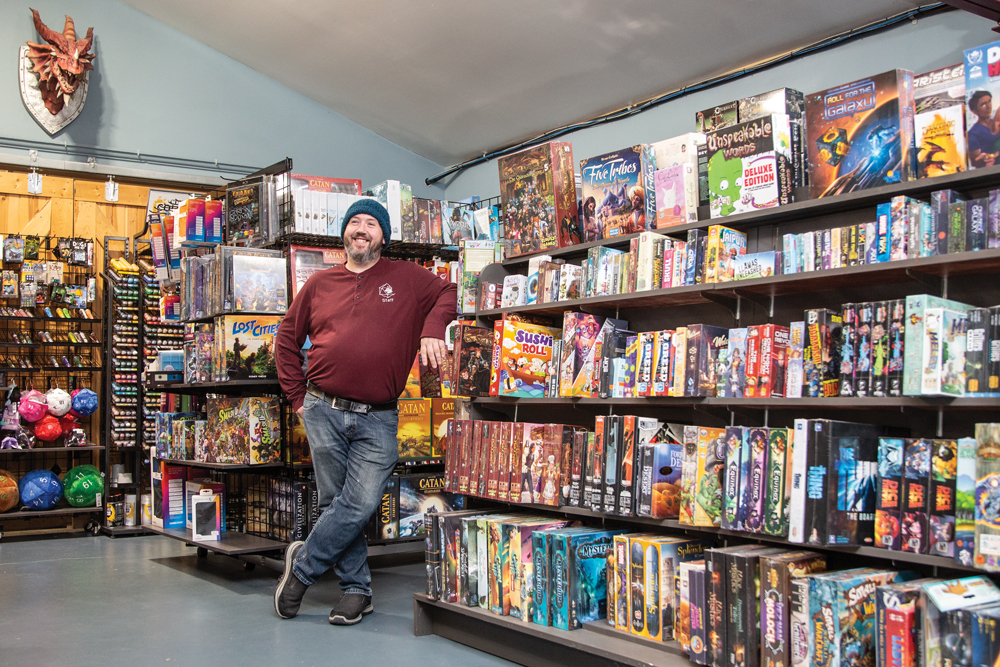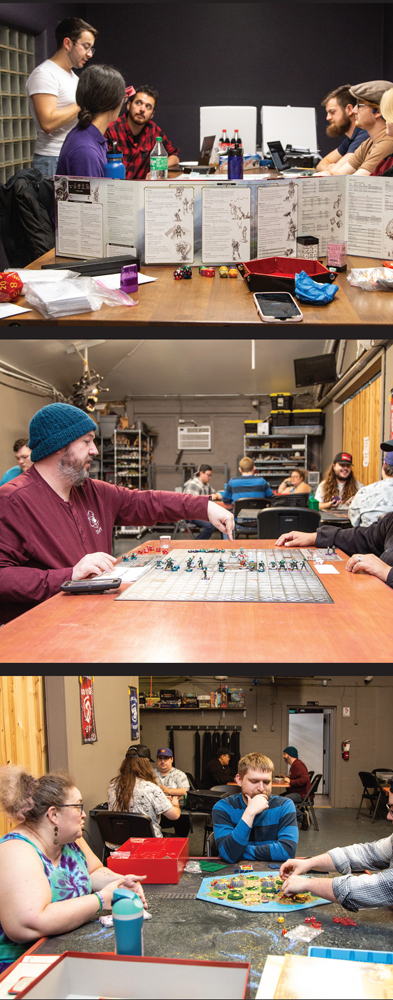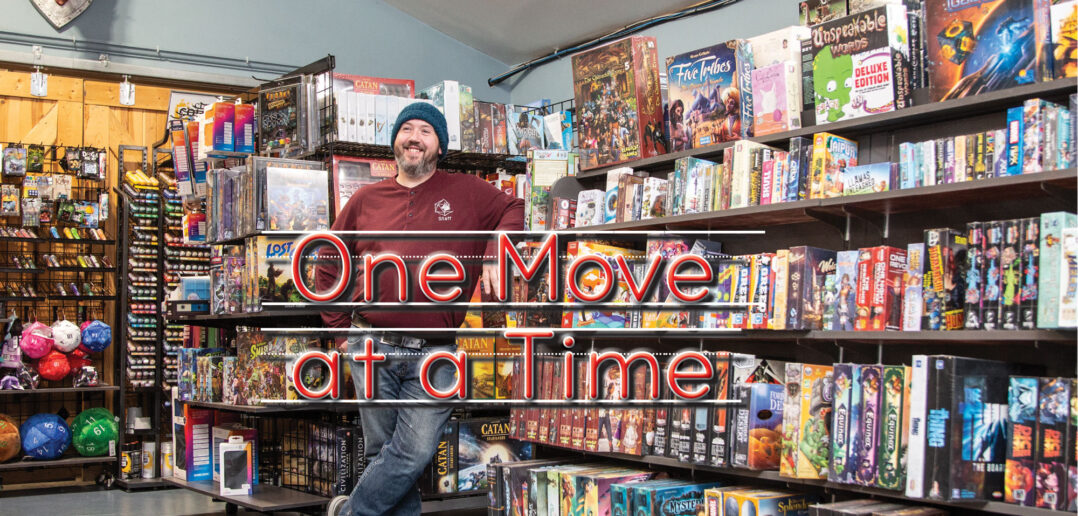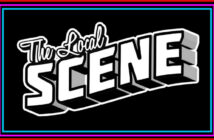| story by | |
| photos by | Steven Hertzog |
| OPEN A PDF OF THE ARTICLE |
In the world of serious board gaming, personal interaction is preferred by many, and math is an intrinsic piece of the puzzle.

The Dragon’s Hoard, D.J. Cooper
The Dragon’s Hoard, located at 1045 Pennsylvania St., is owned by D.J. Cooper, Gage Buffington and Ann Cooper, and opened in October 2018. The tabletop gaming store is focused both on selling games to the Lawrence community and “creating a place for people to gather and game,” with its side room featuring tables and space for local gamers to meet and play in person. That physical gathering space was very important to the business from the start, says D.J. Cooper, The Dragon’s Hoard’s primary operator of daily activities.
“When I first moved to Lawrence, it had five different game stores, but most of them were all focused more on retail,” D.J. recalls. “None of them really worked on the community. Over the 10 years I was in town, they slowly closed, and I’ve always been a big fan of the community, which is what makes game stores work.”
The profit margins on these products are so highly controlled, it’s hard to make money, D.J. explains. So he’s always been a fan of focusing on community and being a place for people to hang out rather than simply to sell a product.
“I’ve been gaming since I was 8 years old,” D.J. says. “I’ve been a consultant for game stores since I was 19 years old, and board gaming has always existed. But finding game stores that would focus on it was always harder, and then when I became a board gamer—when I went to other game stores—I’d ask questions about board games, and nobody knew the answer.”
That was always a frustration for D.J. because he’d want to know a little bit about the game, get an actual response from someone who plays, and nothing existed in stores. With the creation of the internet, one can find playthrough videos on many of these games, but D.J. still focuses on knowing all about them so Dragon’s Hoard can advise people on the game that’s best suited to them. Their game space has a demo shelf where folks can try out games.

top to bottom: Haskell Natural 1’s Gaming Club has a room to itself inside The Dragon’s Hoard; D.J. Cooper instructs longtime gamer Scott Freeman on the rules and intricacies of a new game; Friends can sit, eat and play for hours without any distractions
Having someone such as D.J. who’s played games in a store like The Dragon’s Hoard, where one can try out a game, is important because, while there are certainly games where you can set up in seconds and play a whole game in less than half an hour, there are also what D.J. calls “heavy games,” which are games that have play times of between two and five hours. It’s a smaller market, because most people don’t want to sit at a table that long, and many heavy games involve heavy mathematics. D.J. offers up a game called Terraforming Mars as an example.
“It is known as an ‘engine builder,’ where the decisions you’re making early on mathematically multiply as the game goes,” he says. “So, getting plus 1 resource on turn one multiplies into $45 in 10 turns compared to if you played that same card on turn 10. It’s not as cost-effective, and it doesn’t affect your overall engine, because it came in too late.”
Engine builders work by taking a simple mechanic and pairing it with a second simple mechanic, and creating a multiplicable effect. So one thing leads to a second thing, and the player gets a huge payout for very little input. In a game like Terraforming Mars, D.J. continues, there are a lot more choices. As a player of the game, you have a deck of cards that is 400 cards deep with no duplicate cards in the deck. Instead of having known quantities in front of you, you must constantly recalculate the variables. And that’s not even the craziest one, he adds.
“I have some that literally have a textbook when you open the box,” D.J. says, referring to a game called Cthulhu Wars. At the time we spoke, it had almost 20 expansion sets and a core rule book that was 300 pages long. That said, despite all the caveats and weird interactions of Cthulhu Wars, it’s a unique game in the industry because it has all of these rules that have been “FAQd” (a list has been put together explaining how the rules work together), and the game plays in only two hours.
LOCAL MATTERS
Our Local Advertisers – Making a Positive Impact
“For all the complexity of the game, it has very simple rules, and it mostly acknowledges the interactions between different rules,” D.J. clarifies. “If you don’t have those interactions, then 80% of the rulebook didn’t really matter.”
Interestingly enough, the more he explains modern tabletop gaming, the games seem less mathematically driven and more akin to logistical problems. It’s very much a series of if-then statements.
“Yep,” D.J. enthusiastically concurs. “The games that involve the most mathematics, besides tallying up your score at the end, are going to be a lot more engine builder-style games.”
As to why folks like to get together and play these games, D.J. believes that we, as humans, love personal contact, and even though we’re very much connected online, that’s not enough for most people who desire personal contact.
“Hanging out in a chat room with someone all night doesn’t do it,” he says. “One of the things that humans strive to be is in front of each other, so board games have just become an amazing medium for that in the U.S.”
In the board game market, the United States is actually behind. For example, Germany and the United Kingdom are both big board game countries, and there’s no nerdy stigma behind it. It’s a family thing. In the States, there are games such as Monopoly and Risk, whereas overseas, games such as Carcassonne, Settlers of Catan and even games like Terraforming Mars are simply family games.
“Monopoly’s barely known over there because they have other, better board games,” D.J. explains. “It’s just a thing over there. Gaming has always had a weird stigma in the United States.”
He attributes the lack of a tabletop gaming culture in the United States to the fact that the original board games were all heavy games and kept a lot of people out of it.
“Board gaming was always this weird niche where most of the board games were ugly, and I didn’t want to play,” D.J. admits. “I mean, I was aware of them. I had a librarian that taught me how to play a really old military game called Platoon.”
He describes Platoon as “the (most) hideous game you ever saw,” with white cardboard tiles on a black and white grid with number values. It was a harder game to play than chess, he continues, because there were more caveat rules such as if your tank division runs into an infantry division, you have to calculate what that infantry division’s weapon loadout is and what the odds of them hurting this tank were. Nowadays, D.J. says a lot of the math in games is hidden behind actions or a part of the board game design.
“The player never sees the mechanics, so one card will have a plus 1 on it, one card will have a plus 2, and one card will have a plus 3, but I know the bell curve is 36%,” he adds. “All the math goes in the back, and then they change the way it looks to make it easier to flow to the customer or the consumer, because you want it to be fun.”
D.J. says he’s learned there are people who will sit down and love to know the fact that it’s a 33% or 60% bell curve, or whatever the mechanics might be, but that’s not most people. That whole culture has changed and continues to change.
“The fact that … you can be like, ‘I build custom cars,’ and everyone goes, ‘Oh that’s cool.’ But, ‘I play board games,’ ‘Oh, you must be a nerd,’ has always held back people wanting to get into it,” he explains. But with the change of opinion and culture, it’s really moved the percentages and perceptions, and now, one in three people have played or at least are aware of Dungeons & Dragons (D&D).
And even Dungeons & Dragons has changed, D.J. continues. Now for all its complexity, essentially all that’s needed is paper, dice and your imagination. Once upon a time, in the early days of D&D, there were more complex equations you used to calculate things such as armor class, because it was more about representing true facts.
“It would take five minutes to puzzle it out and to actually sit down and do an equation,” he marvels. “Now they literally go, ‘Alright, you went up a level, you roll a D20 to hit, and you’re level 4, so you get plus 4 to hit. The guy’s [armor class]is just a simple flat number. The math is literally the same but presented in a more logical, easy-to-read format.”
D.J. doesn’t know the folks who wrote the original rules for Dungeons & Dragons, but he has to think they loved math: “Some of the equations [they]came up with to calculate characters and statistical odds … you practically needed a math degree to play original D&D.”





